

Shortly after Russia invaded Ukraine in February 2022, news reports emerged about both sides using weapons that were more than 100 years old. Ukrainian troops were photographed defending a fortified position in the Donbas region with a PM M1910 Maxim machine gun – a weapon manufactured before World War I. The Russian forces allegedly armed their infantry with Mosin-Nagant rifles, first used in 1891. (Even more amazing was a photo of a Russian checkpoint in Kherson being guarded by what appeared to be a 12-pound muzzleloading cannon from the Napoleonic Wars.)
While arms are continually being refined and improved upon, examples from long ago can still be lethal, and are still in use around the world. To identify 24 guns of the past used in modern combat, 24/7 Tempo consulted sites including The New York Times, Military Factory, American Rifleman, Pew Pew Tactical, and Atlantic Firearms.
Some of these older weapons are among the best-known small arms ever made. These include the aforementioned Mosin-Nagant rifle, the AK-47, the M1 Garand, the M1 Carbine, and the Lee-Enfield. (These are the U.S. military’s oldest weapons still in use.)
These pistols, rifles, and shotguns have been used by guerrillas, freedom fighters, insurgents, special forces, and militaries on every continent. Some weapons, such as the Soviet-made AK-47, have been closely associated particularly closely with the wars of liberation in Africa. The Lee-Enfield bolt-action rifle, used by British forces during the colonial era, has been in the Taliban’s weapons inventory in Afghanistan.
And as we’ve seen in Ukraine, desperate times call for getting your hands on whatever weapon you can – even if it’s a machine gun made before World War I. (You can be sure, however, that the PM M1910 Maxim is not among the nine fastest-firing machine guns in the world.)
Click here to see guns of the past used in modern combat
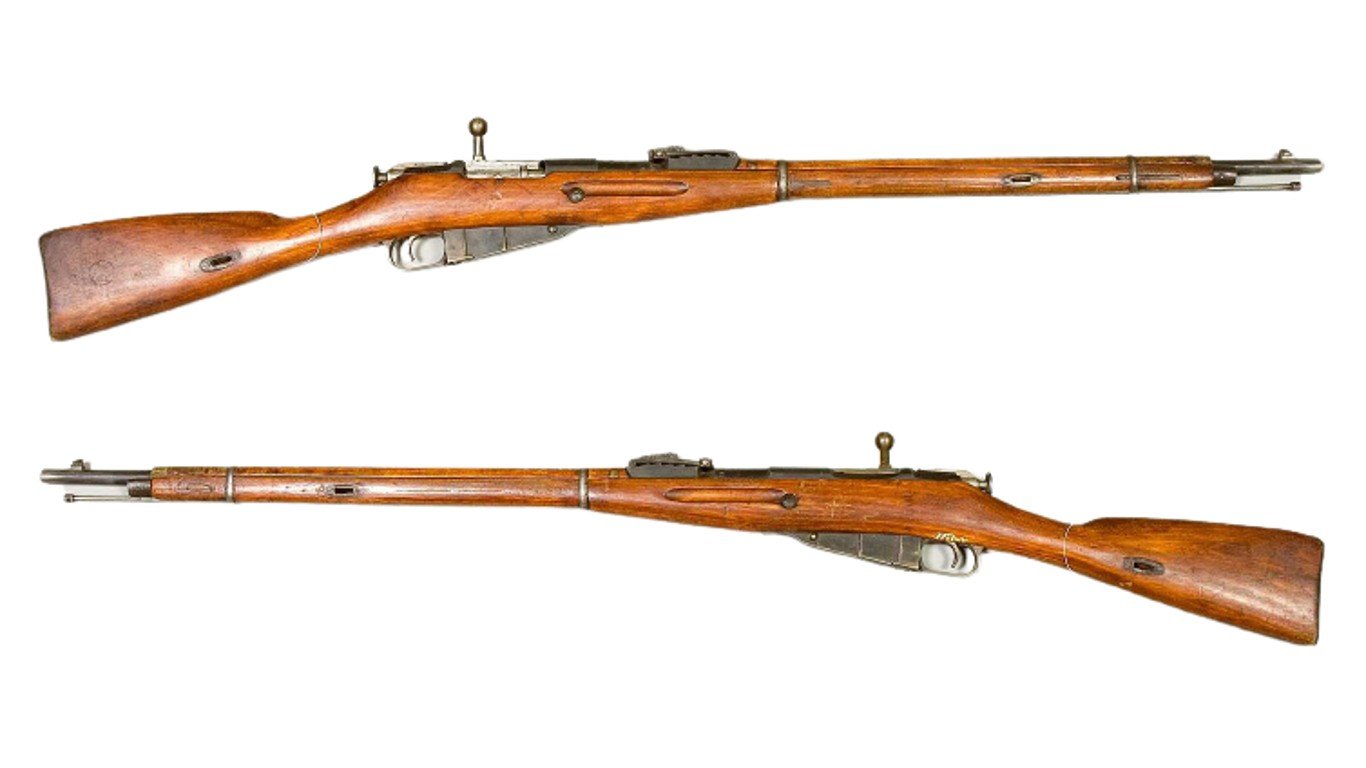
Mosin-Nagant Model 1891
> Year first put into service: 1891
Designed by Russian army officer Sergei Ivanovich Mosin, with elements adopted from Belgian arms maker Léon Nagant Nagant, the five-shot bolt-action Model 1891 was carried by the Russians in both world wars, and was the primary firearm used by the Soviet Union in World War II. More than 37 million were made, and it was highly popular among soldiers due to its rugged nature and long-range accuracy. It saw service in the Spanish Civil War, Chinese Civil War, Korean War, and Vietnam War, among other conflicts; was used during Russian-Chechen wars; and was employed against Coalition troops in the wars in Afghanistan and Iraq. The Mosin-Nagant was also allegedly given to undertrained Russian conscripts during the invasion of Ukraine in 2022.
[in-text-ad]
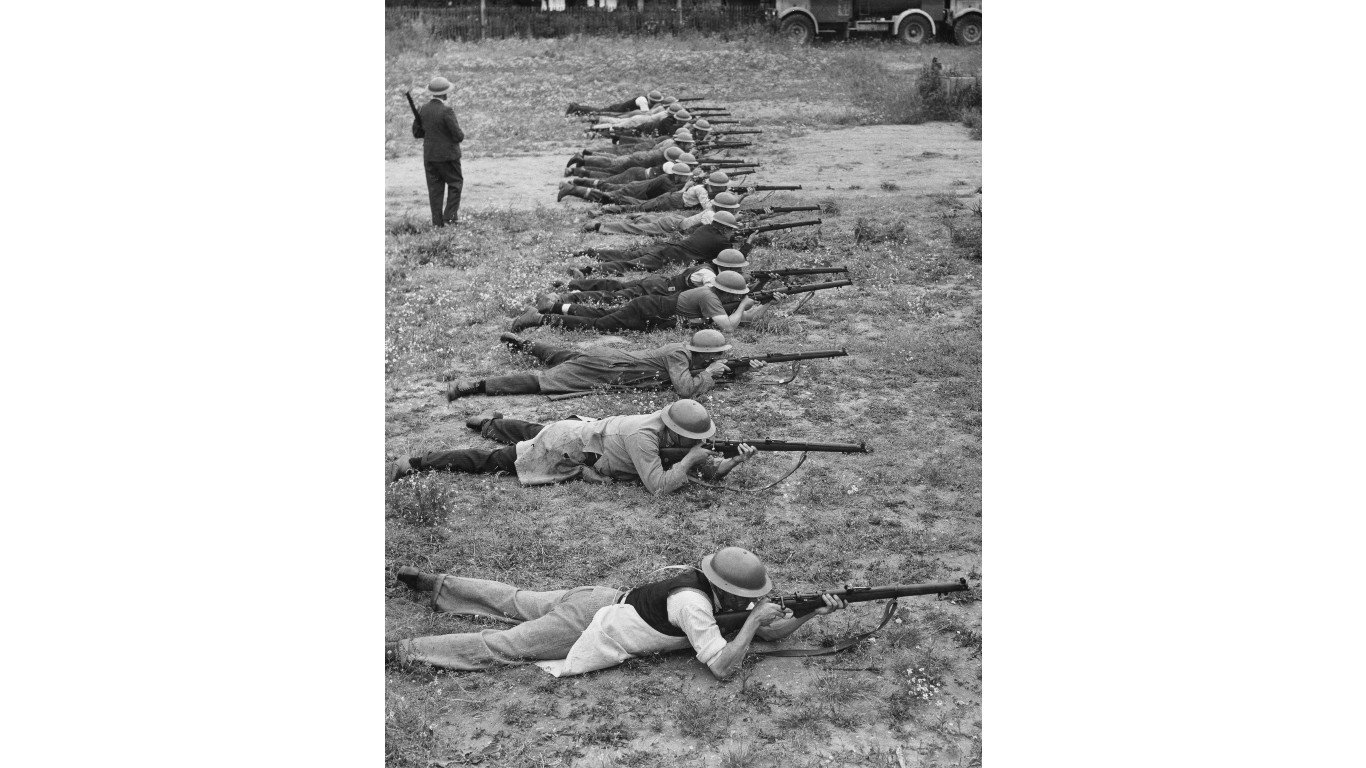
Lee-Enfield
> Year first put into service: 1895
There have been more than a dozen models of the bolt-action Lee-Enfield and numerous adaptations of it, and it has been manufactured by eight or ten arms makers in half a dozen countries. It was the rifle most commonly used by British colonial forces and their Commonwealth successors around the world, and the standard for the British Army until as late as 1957. More than 17 million were produced from 1895 to 1957, and it was the second-most manufactured rifle during the Second World War. It was a popular item on the black market in Afghanistan and used there by the Taliban and the militias of local warlords. It is still found in the armies and police forces of some Commonwealth countries.
Česká Zbrojovka vz. 24
> Year first put into service: 1924
This Czechoslovakian-made bolt-action rifle, based on Germany’s Mauser Gewehr 98 rifles and last produced in 1942, was used by Axis forces during World War II and saw service in the Second Sino-Japanese War and many conflicts after World War II – as recently as the Nigerian Civil War, from 1967 to 1970.
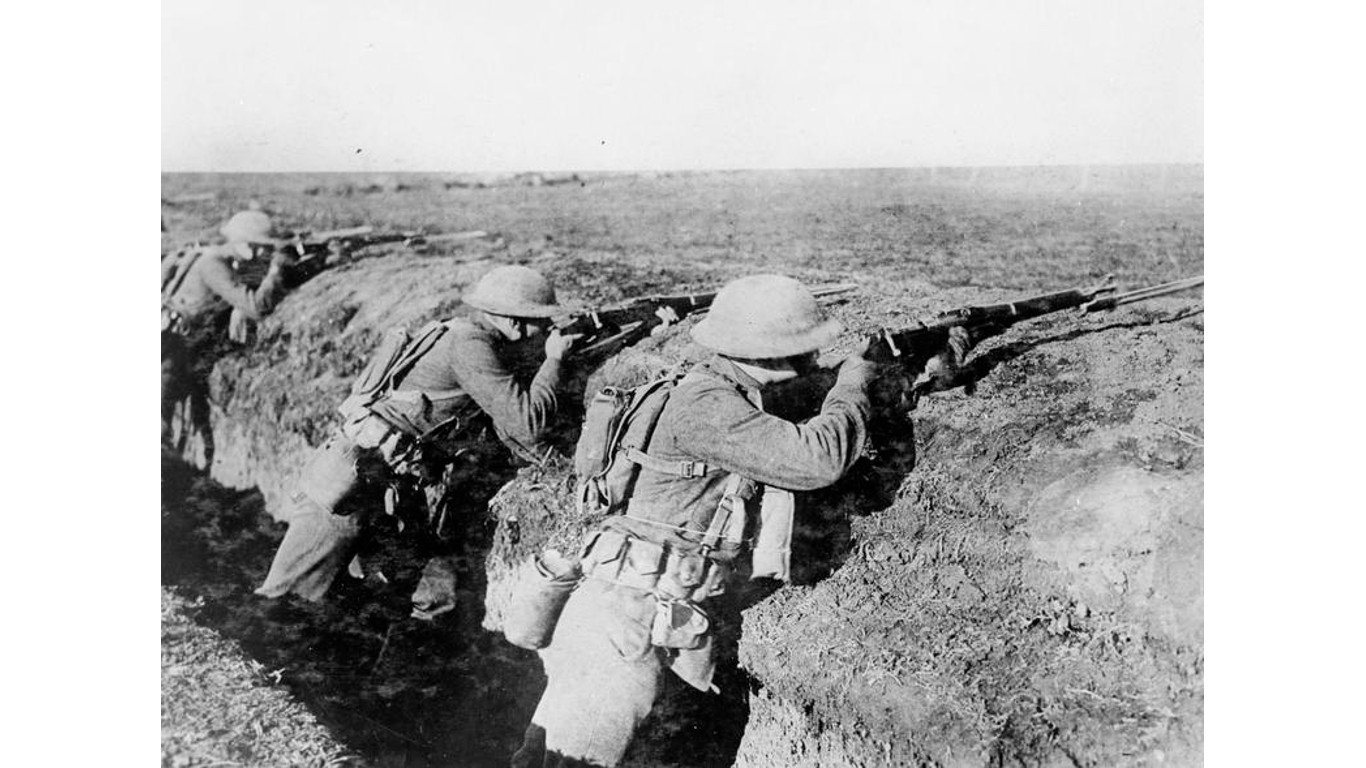
M1903 Springfield
> Year first put into service: 1903
This popular magazine-fed bolt-action repeating rifle was the standard infantry rifle for the U.S. Army from the early years of the century through the end of World War I, but remained popular in World War II, during which it was a favorite weapon for snipers. Even though the rifle was supplanted by the M1 Garand (see below) in 1936, and declared obsolete in 1947, it still served in the Korean War and into the early stages of the Vietnam War.
[in-text-ad-2]
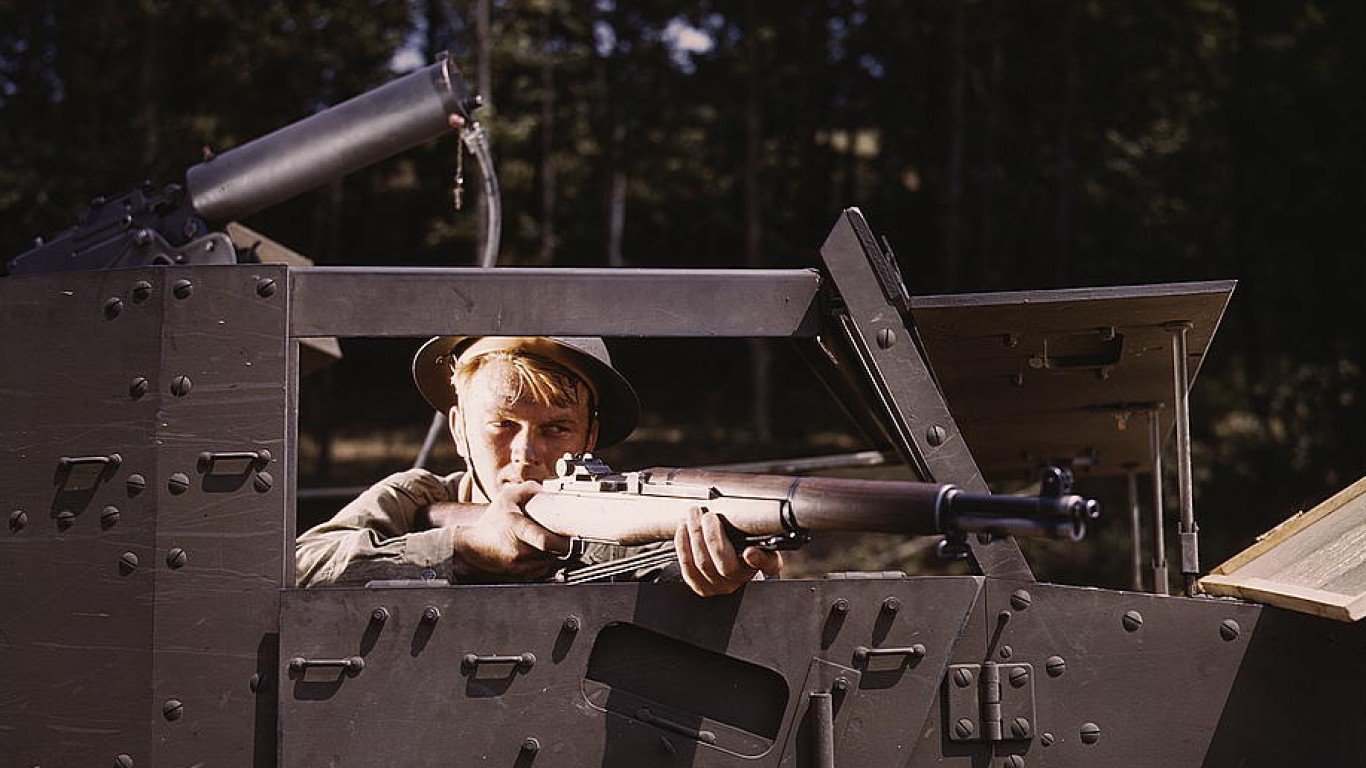
M1 Garand
> Year first put into service: 1936
The M1 Garand is a semi-automatic rifle that largely supplanted the M1903 Springfield (see above) as the standard U.S. Army rifle in World War II, favored over its predecessor for its improved firepower, accuracy, and reliability. Numerous variants of the M1 Garand were used during the Korean War, the Bay of Pigs invasion, the Vietnam War, the Gulf War, the Iraq War, and the Syrian Civil War, among other conflicts, and it is still employed ceremonially today in countries including Turkey, Greece, and Belgium.
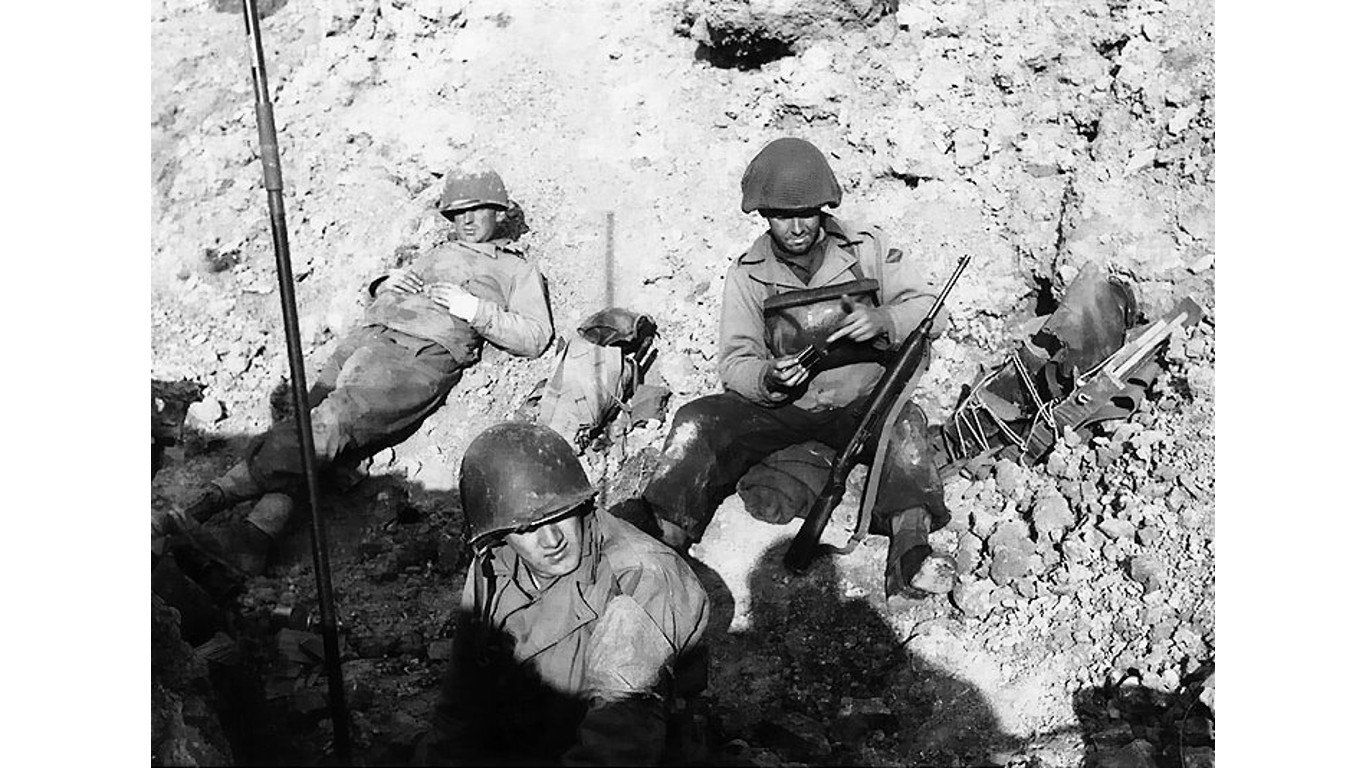
M1 carbine
> Year first put into service: 1942
Despite the similarity of names, this is a different weapon from the M1 Garand – a semi-automatic carbine (a rifle with a shortened barrel) first used by American forces during World War II, and later seeing service in the Korean and Vietnam wars. It was a favorite rifle of Latin American armies and police forces and their rebel opponents through the 1960s, and police units in Indonesia and Brazil still use it
[in-text-ad]
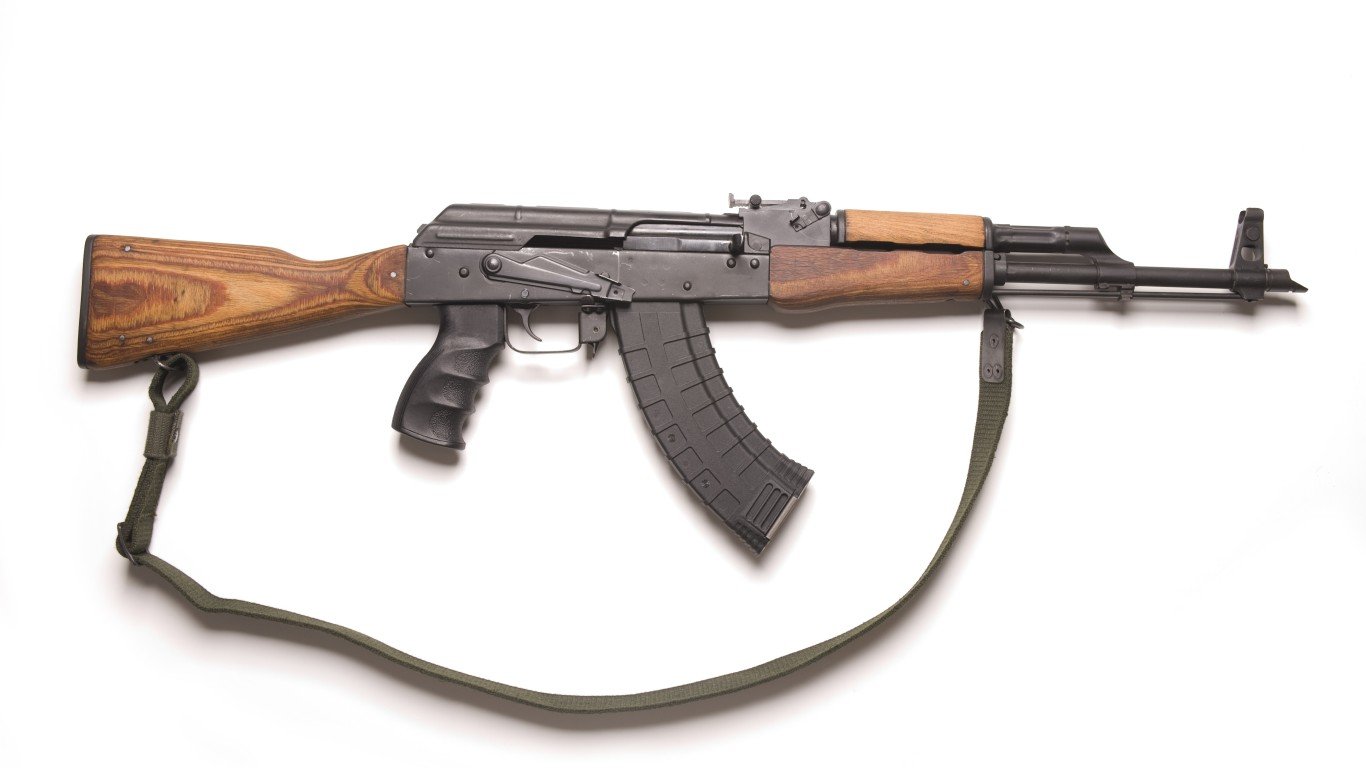
AK-47
> Year first put into service: 1949
The standard rifle used by the Soviet Army and the forces of the Warsaw Pact nations throughout the ’50s and ’60s, the gas-operated AK-47 – also called the Kalashnikov, after its designer – became a symbol of left-wing revolution and liberation wars. Between 30 million and 50 million AK-47s and variations and copies of it have been produced globally, making it one of the most widely used rifles in the world. It is popular with Mexican drug cartels, has been widely utilized in Iraq and Afghanistan, and is one of the weapons used by both sides in Russia’s invasion of Ukraine.

Fabrique Nationale Model 1949
> Year first put into service: 1949
The Belgian-made Fabrique Nationale Model self-loading automatic rifle – described by American Rifleman as “the last old-school battle rifleâ¦made of forged, blued steel and walnut” – saw combat in the Korean War, the Congo crisis of the early 1960s, and the Falkland War, among other conflicts. It was particularly popular with the armed forces of various non-aligned nations during the Cold War, including Egypt and Indonesia.
Remington Model 870
> Year first put into service: 1950
The pump-action Remington 870, which has been described as “one of the kings of American shotguns,” saw service in the Lebanese civil war and the wars in Vietnam and Iraq. As many as 10 million of these weapons, in numerous variations, have been sold, and they’re still widely used around the world by military and police forces. It is also a popular choice for hunting and self-defense in the civilian world.
[in-text-ad-2]
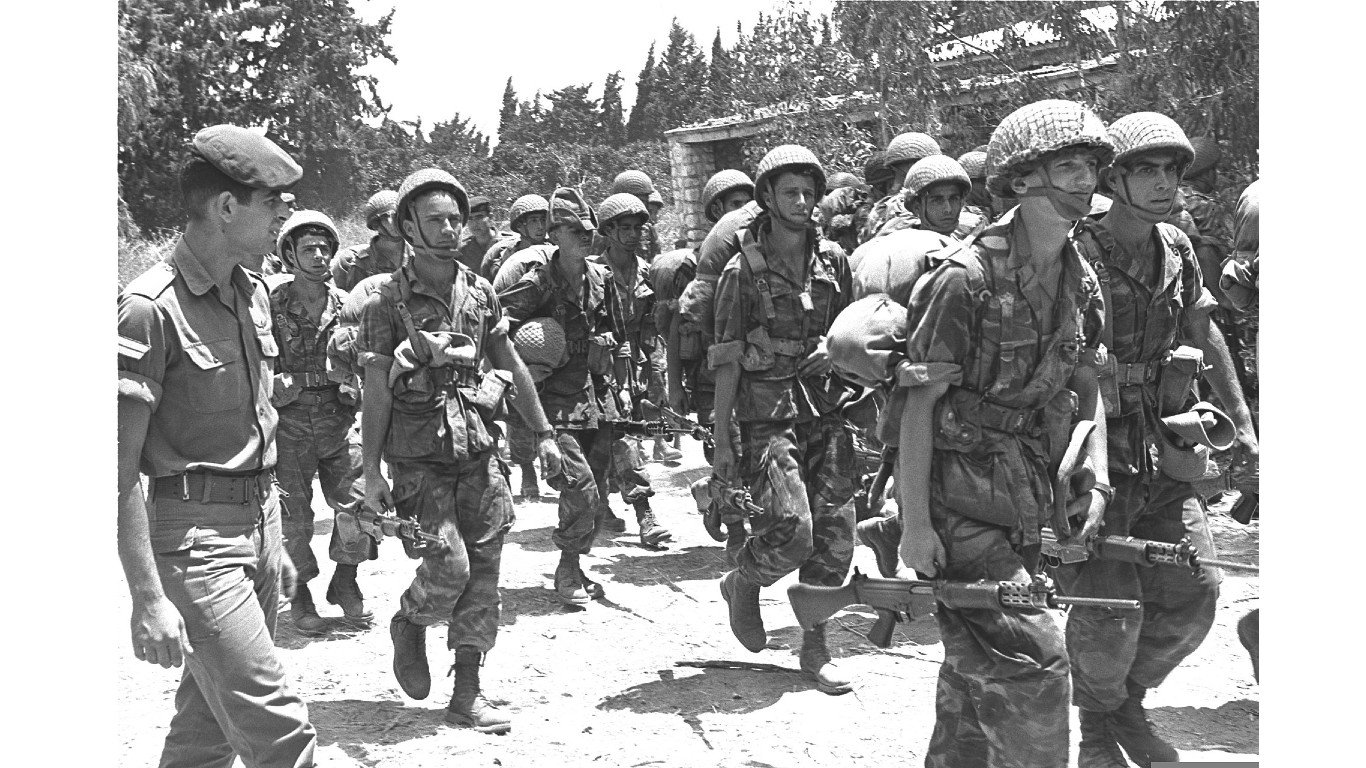
Fabrique Nationale FN FAL
> Year first put into service: 1953
The Belgian-made FN FAL battle rifle became a symbol of the NATO small arms inventory during the Cold War, earning it the nickname “the right arm of the free world.” Considered one of the most widely used rifles of all time, the FN FAL has seen action in countless conflicts in as many as 90 nations worldwide, and was particularly popular in Africa. It has also figured prominently in numerous 21st-century wars and rebellions in the Middle East and Russia’s invasion of Ukraine, and is commonly utilized by Mexican drug cartels.
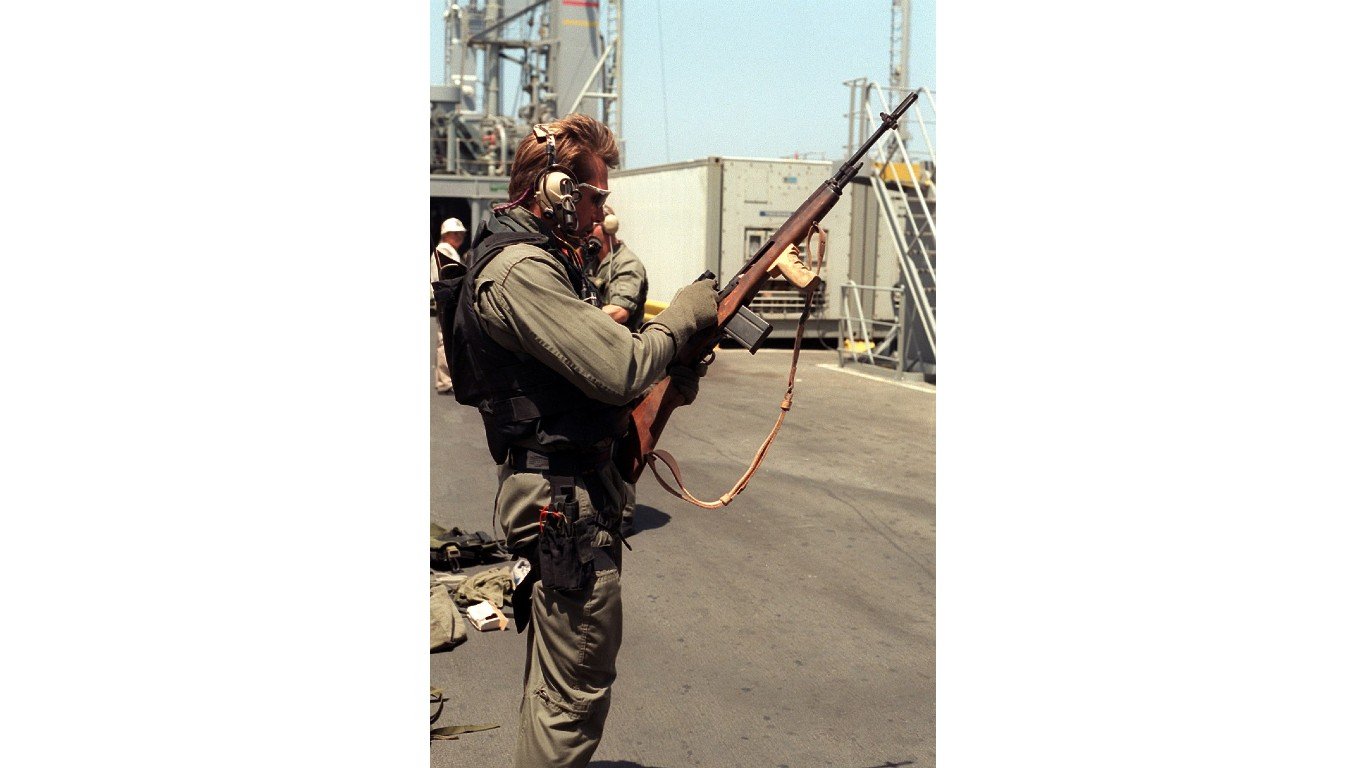
M14 rifle
> Year first put into service: 1957
The successor to the M1 Garand, the Browning Automatic Rifle, and other earlier firearms, the M14 was the primary American infantry battle rifle from 1957 to 1967, when it was itself replaced by the M16 (see below). Still used by the United States and other nations in a ceremonial role, it is currently carried by members of the U.S. Border Patrol and by Park Rangers. It saw service in the Vietnam, Falklands, and Iraq wars, among others, and – like so many older weapons – is currently being used in Ukraine.
[in-text-ad]
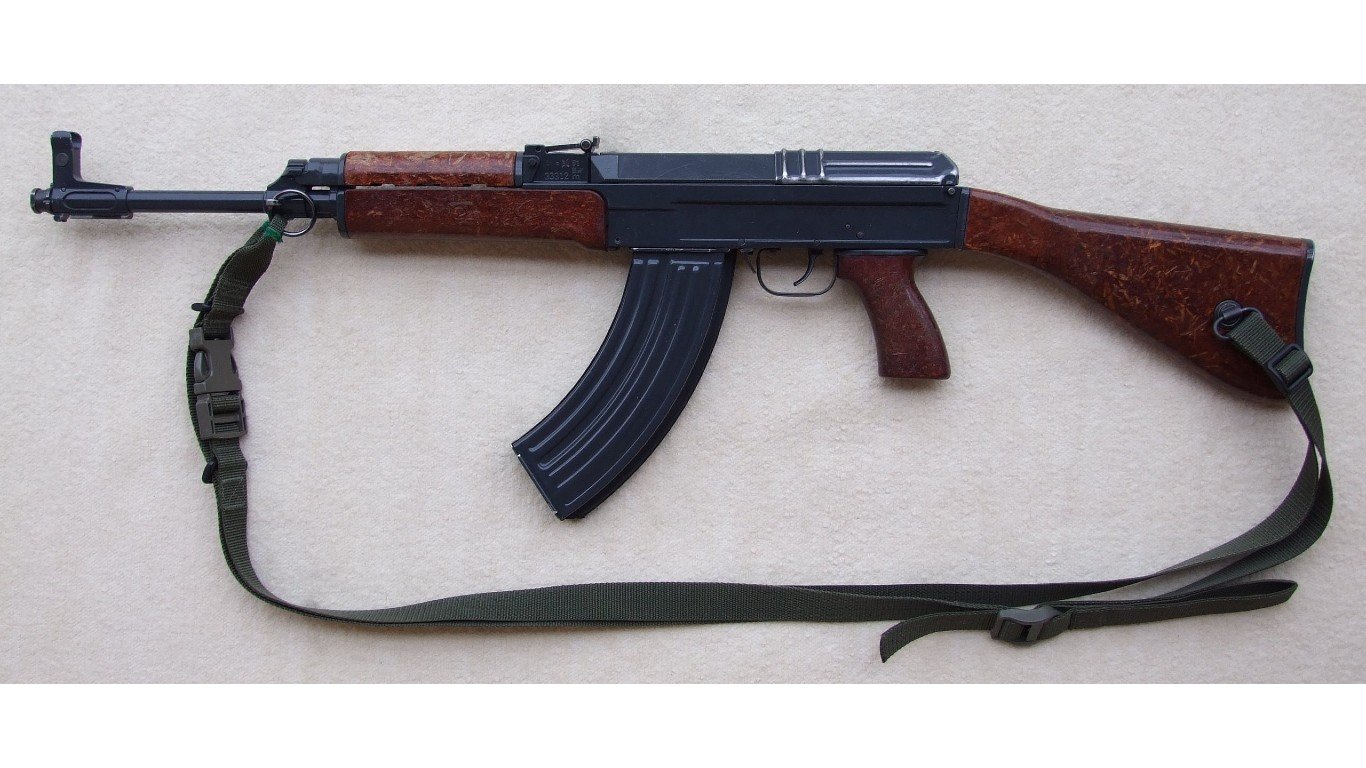
Česká Zbrojovka vz. 58
> Year first put into service: 1958
Similar in appearance to the Soviet AK-47, though with important design differences, the vz. 58 assault rifle was the mainstay of the Czechoslovakian and then the Czech infantry from its introduction until 2011, and is still the standard service rifle in Slovakia. It is currently in use in more than 20 countries, including Afghanistan, Ethiopia, India, Iraq, and Libya, and the Czechs recently delivered some 5,000 of the rifles to Ukrainian forces.
Heckler & Koch G3
> Year first put into service: 1959
Described by Gun Digest as “the world’s most successful battle rifle,” the Heckler & Koch G3 uses a roller-delayed blowback system (which uses the power of the gun’s recoil to cycle the action). It was developed in Germany, with input from the Spanish government-owned small arms development company, CETME. Variants and G3-inspired weapons, often made under license in various countries, are in use around the world today, from Afghanistan to Zimbabwe, and have been employed most recently in the Myanmar civil war and the Russian invasion of Ukraine.
Beretta BM 59
> Year first put into service: 1959
This was the Italian infantry’s standard weapon until 1990. The gun’s Italian designers based it on the M1 Garand, rechambered and with a detachable 20-round box magazine, extendable bipod, and flash suppressor/grenade launcher added. Used in civil wars in Lebanon, Libya, and Somali, it is also still employed in about a dozen countries, mostly in Africa and the Middle East.
[in-text-ad-2]
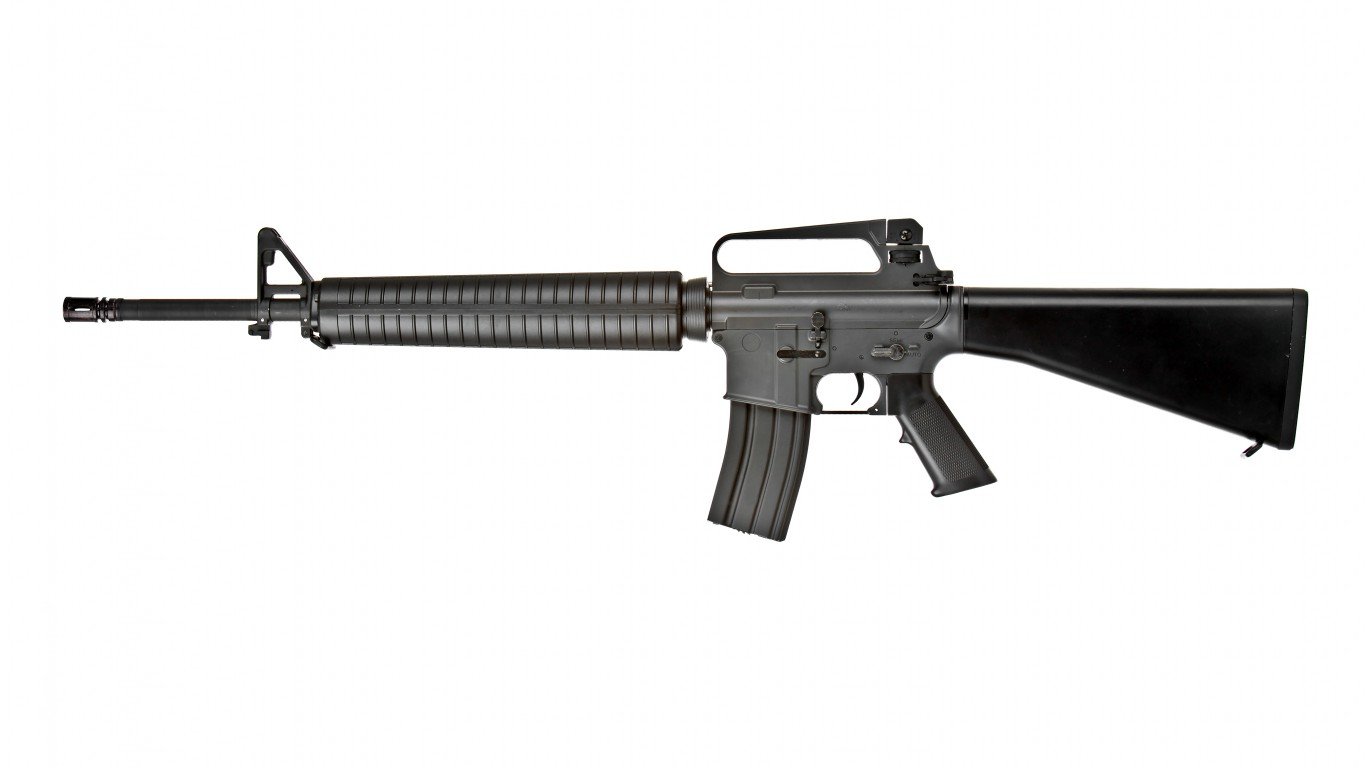
M16 rifle
> Year first put into service: 1963
The M16, which replaced the M14 (see above), came into service in 1963 and was used by American forces in Vietnam as early as 1965. After the Army changed the assault rifle’s cartridge specifications, it developed jamming issues, a frequent problem encountered by soldiers serving in Southeast Asia. Used this century in Afghanistan, Iraq, Lebanon, Ukraine, and elsewhere, it has been part of the armory of more than 125 nations and insurgent groups in the past, and variants are currently utilized in Afghanistan, Argentina, Sierra Leone, Peru, Netherlands, and other countries. The AR-15 assault rifle, wielded by numerous murderers in mass shootings around the U.S. in recent years, is a civilian counterpart to the M16.
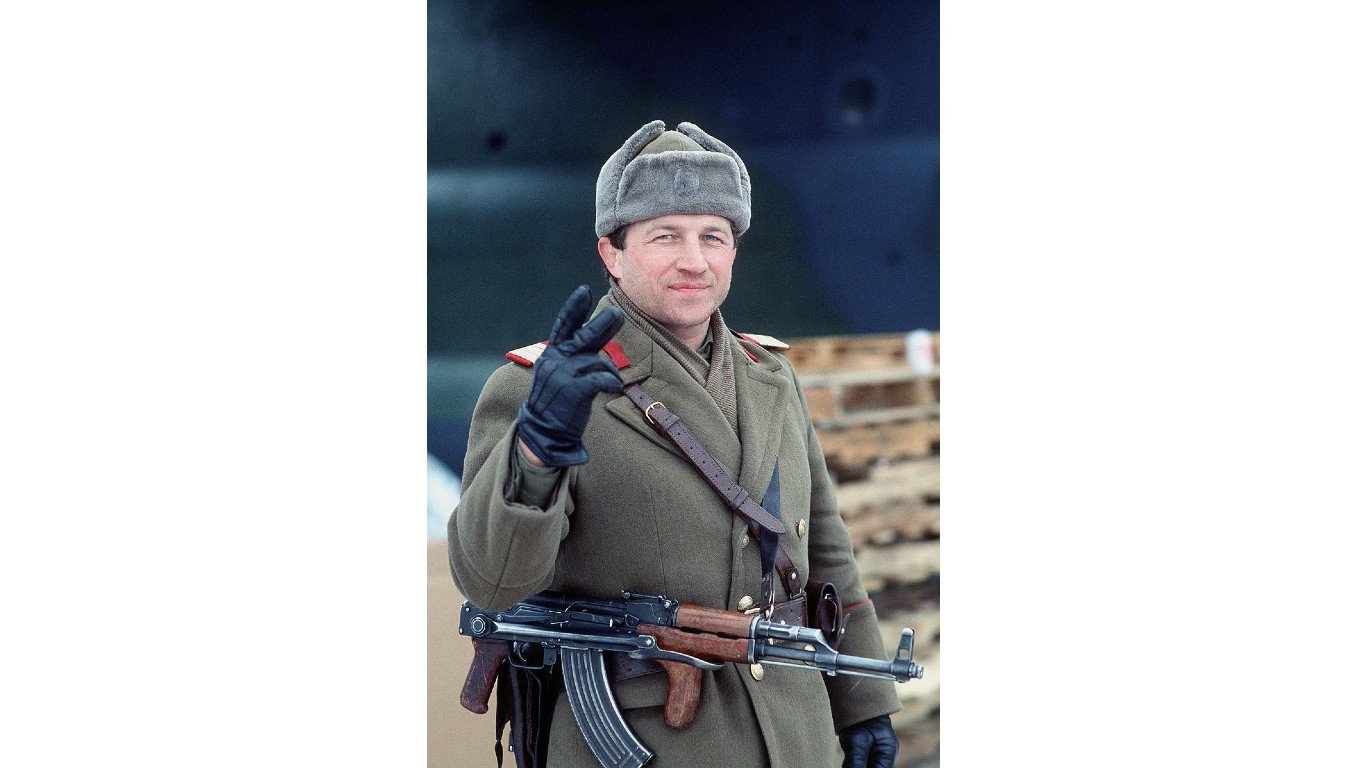
Pistol Mitralieră assault rifle
> Year first put into service: 1963
Despite its name, this Romanian-made weapon is not a pistol, but an assault rifle whose design was inspired by the iconic Soviet AK-47. Manufactured until 1994, it is currently in use by about 15 countries, including Croatia, Estonia, Mali, Nicaragua, and Saudi Arabia, and about a hundred of the weapons are used by the U.S. Army for training purposes.
[in-text-ad]
FEG AMD-65
> Year first put into service: 1967
The FEG AMD-65 is a Hungarian-made interpretation of the famed AK-47 assault rifle. It has seen service in Afghanistan, Cuba, Honduras, Palestine, Yemen, Somalia, and elsewhere, and has been part of the arsenal of numerous guerrilla and insurgent groups. The rifle went out of production in 1980, but was used by the Hungarian military until as late as 2006.
Winchester Model 1200/Model 1300
> Year first put into service: 1964
The Winchester Model 1200 and then its almost identical sibling, the Model 1300, were pump-action shotguns manufactured by the U.S. Repeating Arms Co., until it filed for bankruptcy in 1989. Production was then taken over by the Belgian arms maker Fabrique Nationale until 2006. American armed forces have used variants on the gun in the Vietnam War, Operation Desert Storm, the war in Afghanistan, and other conflicts.

AK-74
> Year first put into service: 1974
The AK74 assault rifle was developed by the famed Russian weapons designer Mikhail Kalashnikov as a replacement for his iconic AK47. It was used in sustained combat as early as 1979, during the Soviet Union’s war in Afghanistan, and is currently carried by both the Ukrainians and Russians in the war in Ukraine. Many other nations, especially in Africa and Central Asia, also keep it in their arsenals.
[in-text-ad-2]
T65
> Year first put into service: 1976
Designed by Taiwanese engineers and patterned after the Armalite AR-18, the T65 has been used in Paraguay and various Central American countries, during the Liberian and Libyan civil wars, and, most recently, in Iraq. It takes its name from the fact that it was introduced in the 65th year of the Republic of China.
Zastava M76
> Year first put into service: 1976
Similar in many ways to Russia’s famed AK-47, but with the ability to accept a grenade launcher attachment, the Zastava was developed in what was then Yugoslavia, and was the standard sniper rifle used by the Yugoslav Army and then, after the country broke up, by the Serbians, Croatians, and Macedonians. It is known for its accuracy, but also for problems with the magazine that may jam the weapon. A knockoff is produced in North Korea, where it is still in use.
[in-text-ad]
Steyr AUG
> Year first put into service: 1978
The Steyr AUG is an Austrian-made “bullpup” assault rifle (one in which the magazine is behind the trigger instead of in front of it). It is still widely used in Austria’s armed forces and federal police units. It’s the main rifle used by the Tunisian Army, and a variant, made in Australia, is the standard service rifle of the Australian Defence Force. Various other countries also still use the Steyr AUG.
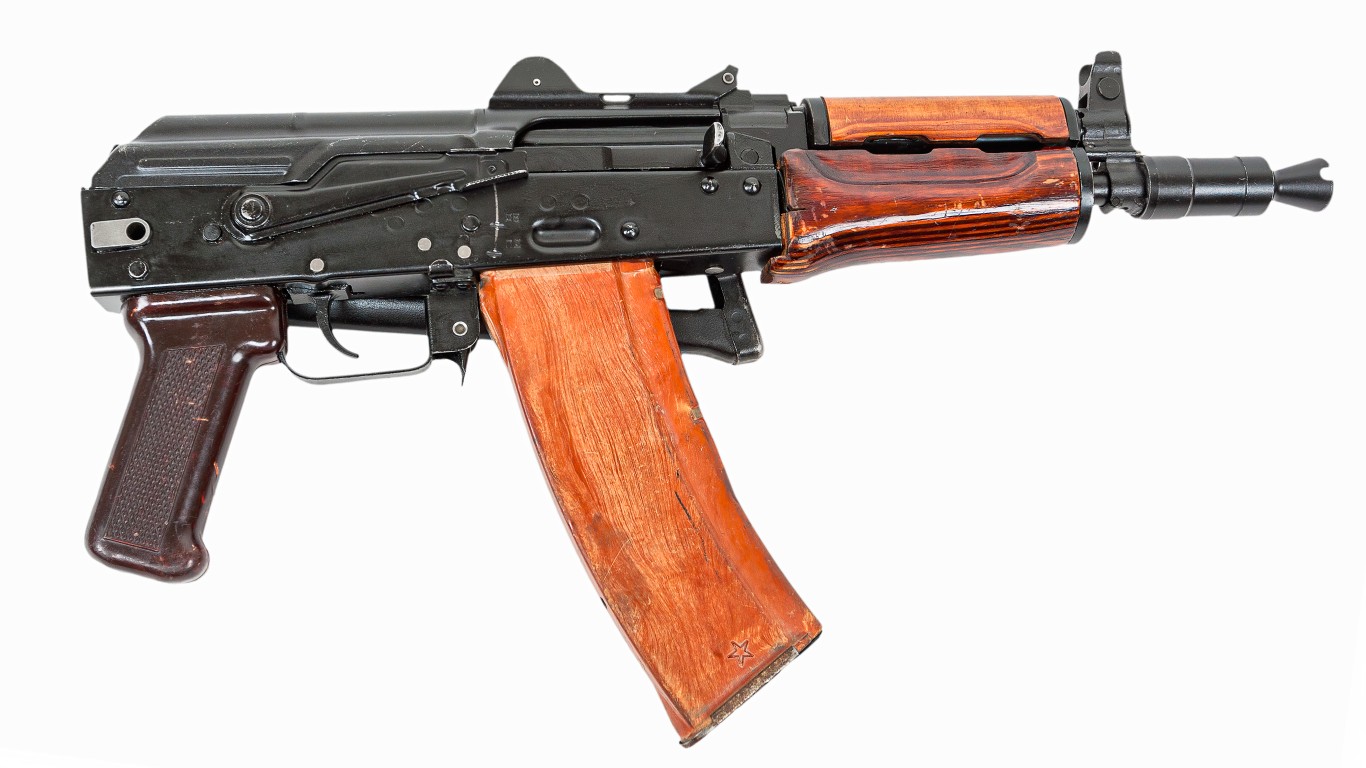
AKS-74U
> Year first put into service: 1979
Another assault rifle designed by Mikhail Kalashnikov, the AKS-74U, also known as the Krinkov, has been called “gangster-looking” for its very short barrel and folding stock. Developed to fill a need for a compact weapon by the Soviet Army, it has served the Soviets and then the Russians in conflicts in Afghanistan, Chechnya, Georgia, Iraq, Syria, and the Ukraine, among other places. It’s also one of the weapons brandished by Pierce Brosnan’s James Bond in the “GoldenEye.”
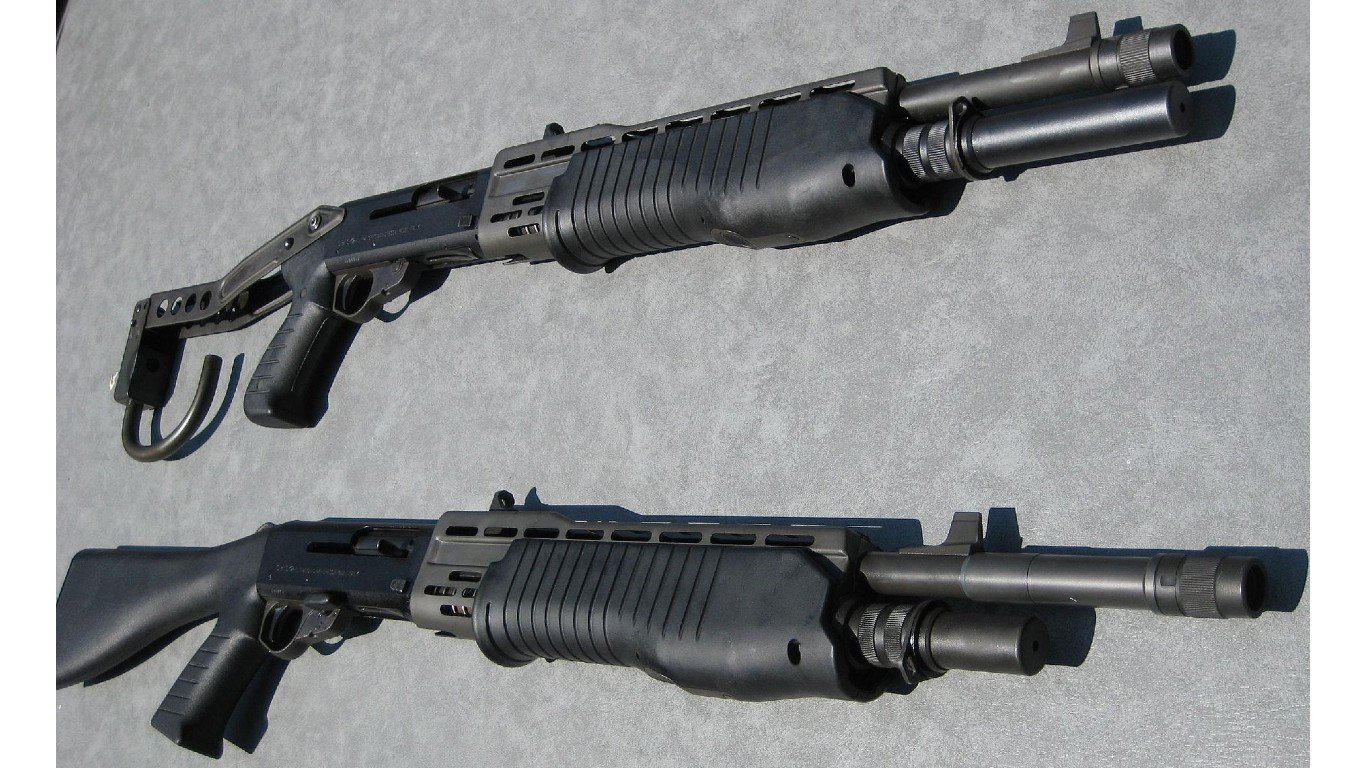
Franchi SPAS-12
> Year first put into service: 1979
The Franchi SPAS-12 is a semi-automatic, 12-gauge combat shotgun made in Italy and used by counter-terrorism and commando units in countries including Austria, Bangladesh, Indonesia, and Malaysia. It is also wielded by some American SWAT teams, and has been featured in countless movies, including “The Terminator,” “The Matrix,” “Jurassic Park,” and “La Femme Nikita.”
Sponsored: Find a Qualified Financial Advisor
Finding a qualified financial advisor doesn’t have to be hard. SmartAsset’s free tool matches you with up to 3 fiduciary financial advisors in your area in 5 minutes. Each advisor has been vetted by SmartAsset and is held to a fiduciary standard to act in your best interests. If you’re ready to be matched with local advisors that can help you achieve your financial goals, get started now.
Thank you for reading! Have some feedback for us?
Contact the 24/7 Wall St. editorial team.
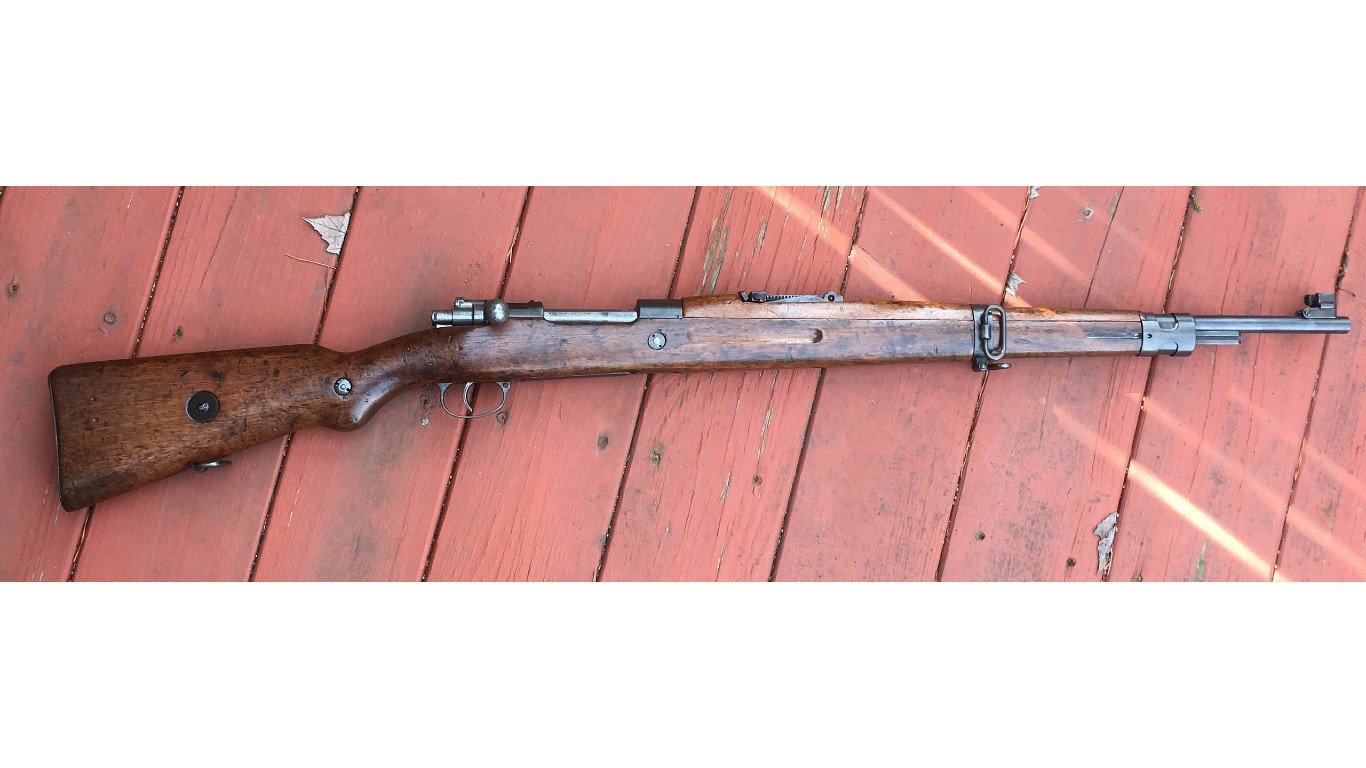
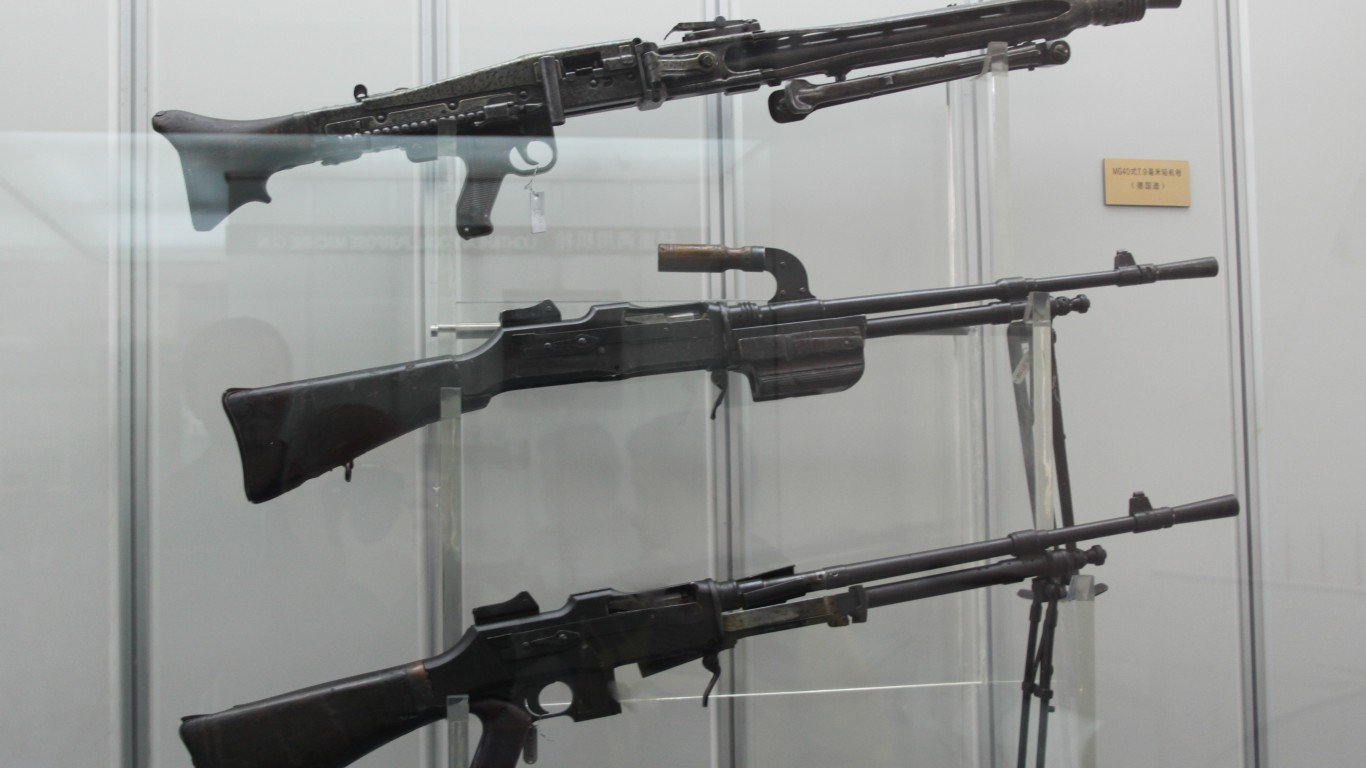 24/7 Wall St.
24/7 Wall St.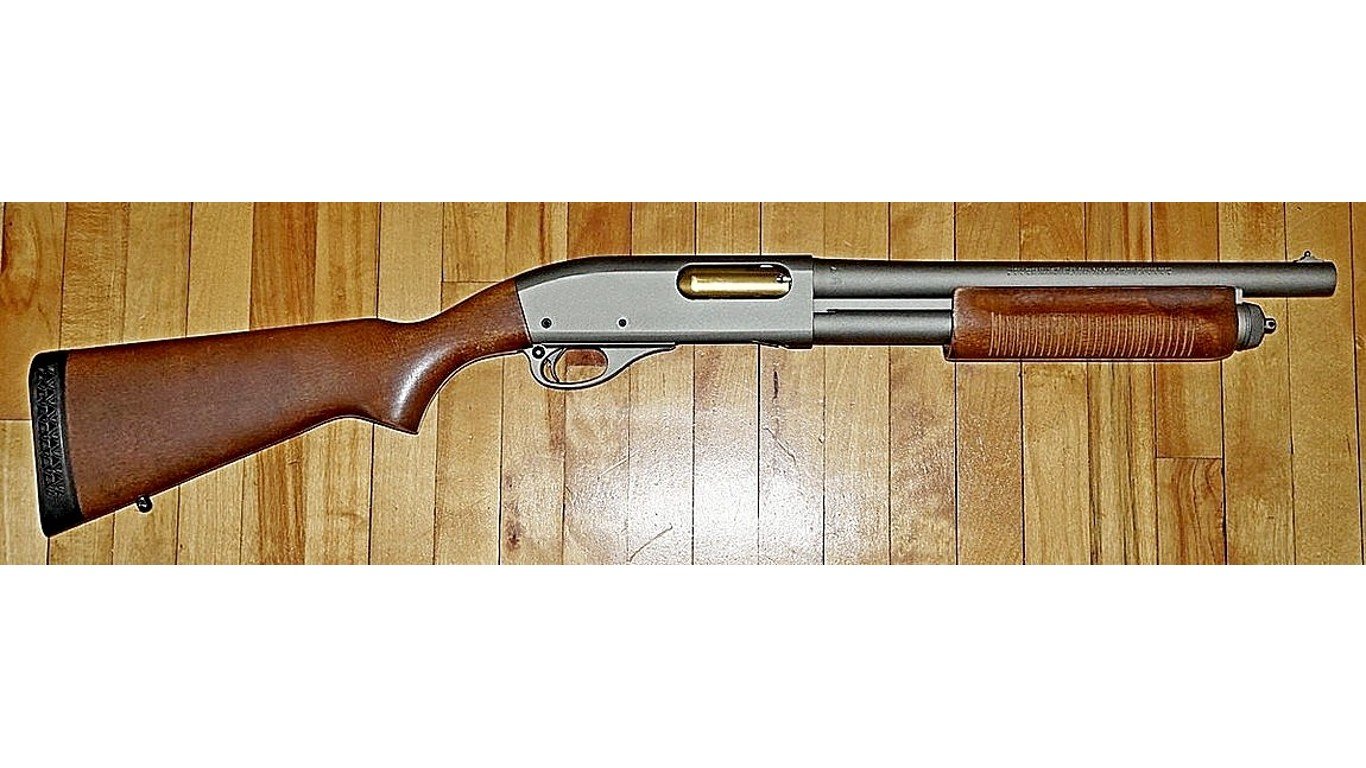
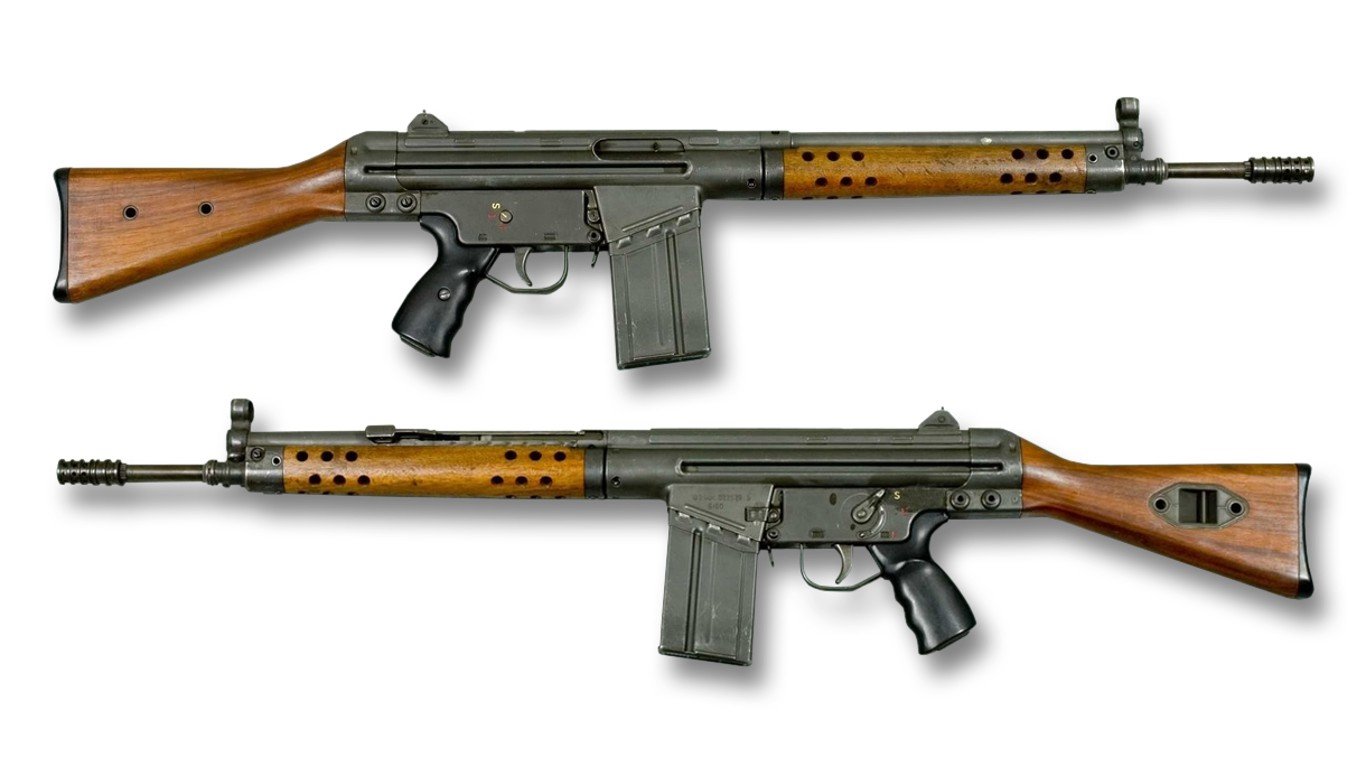
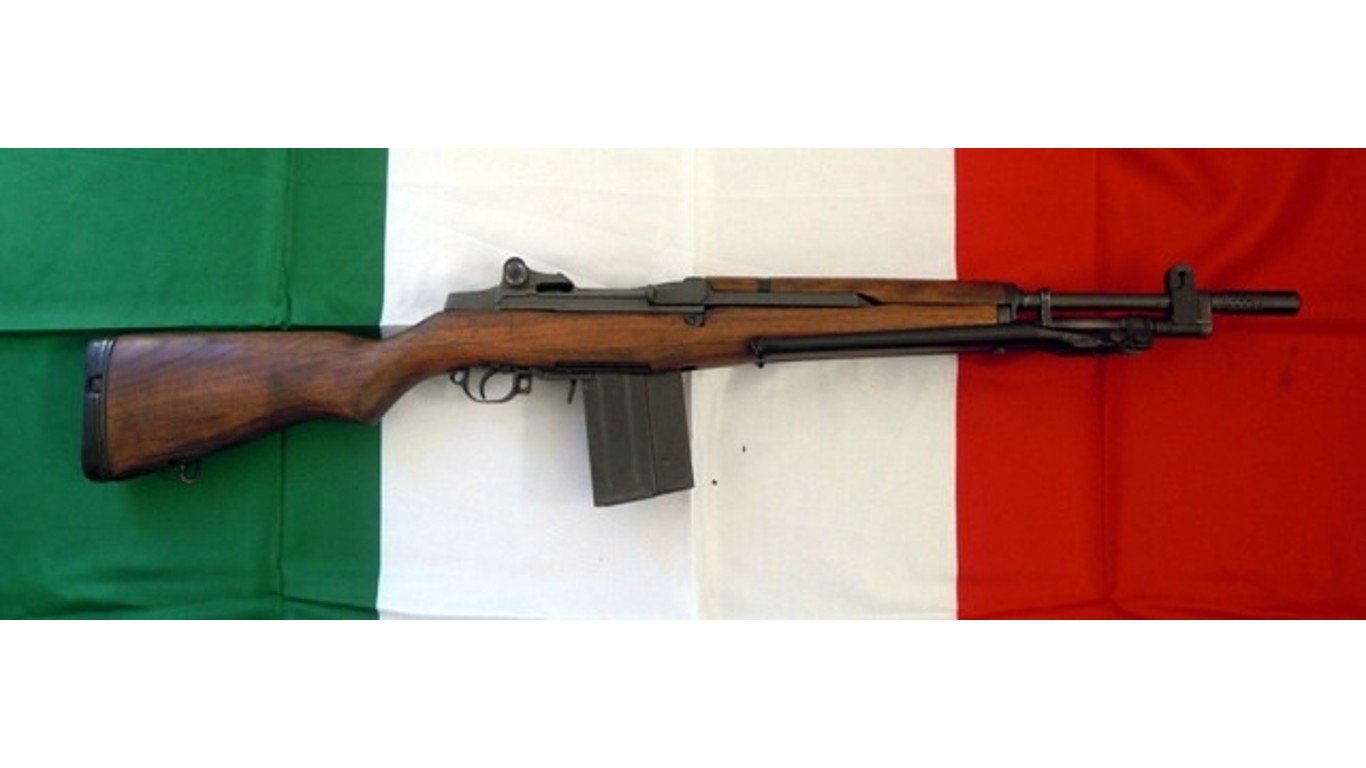

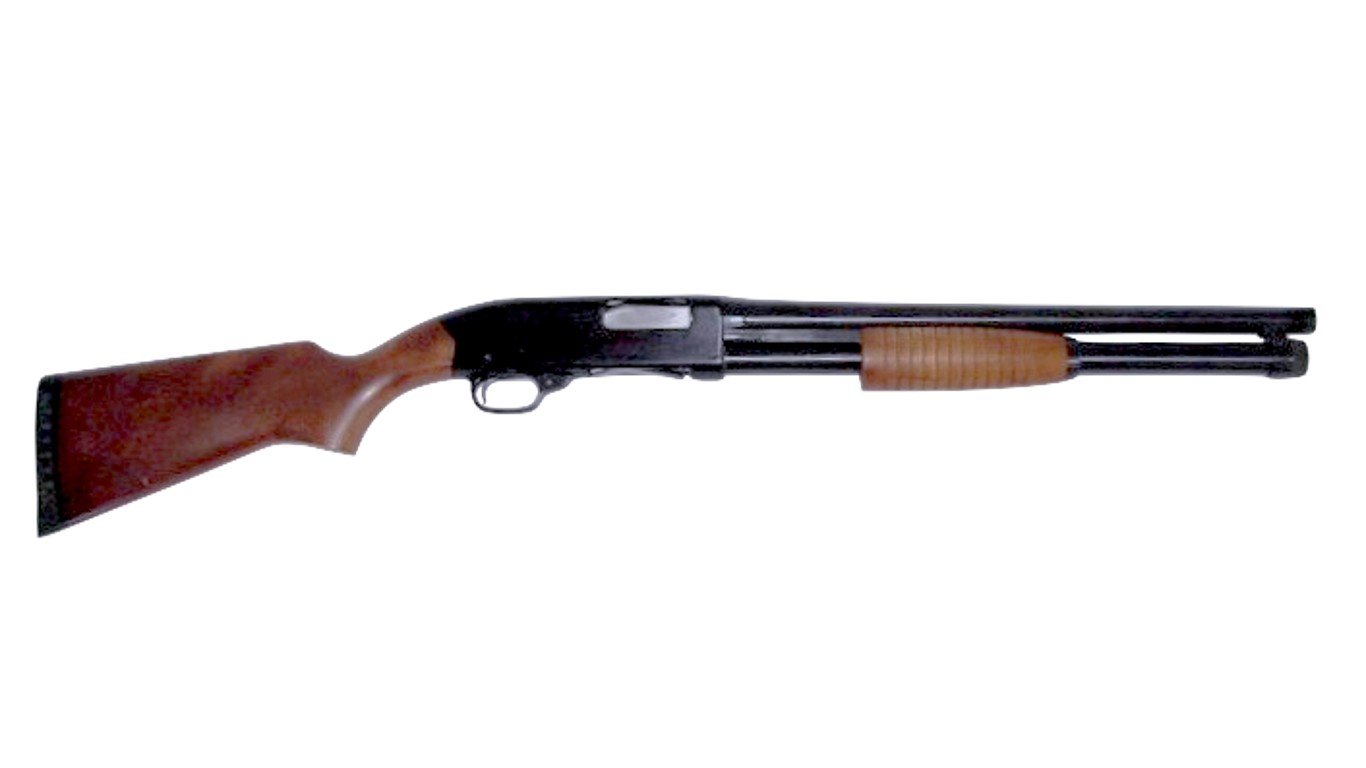
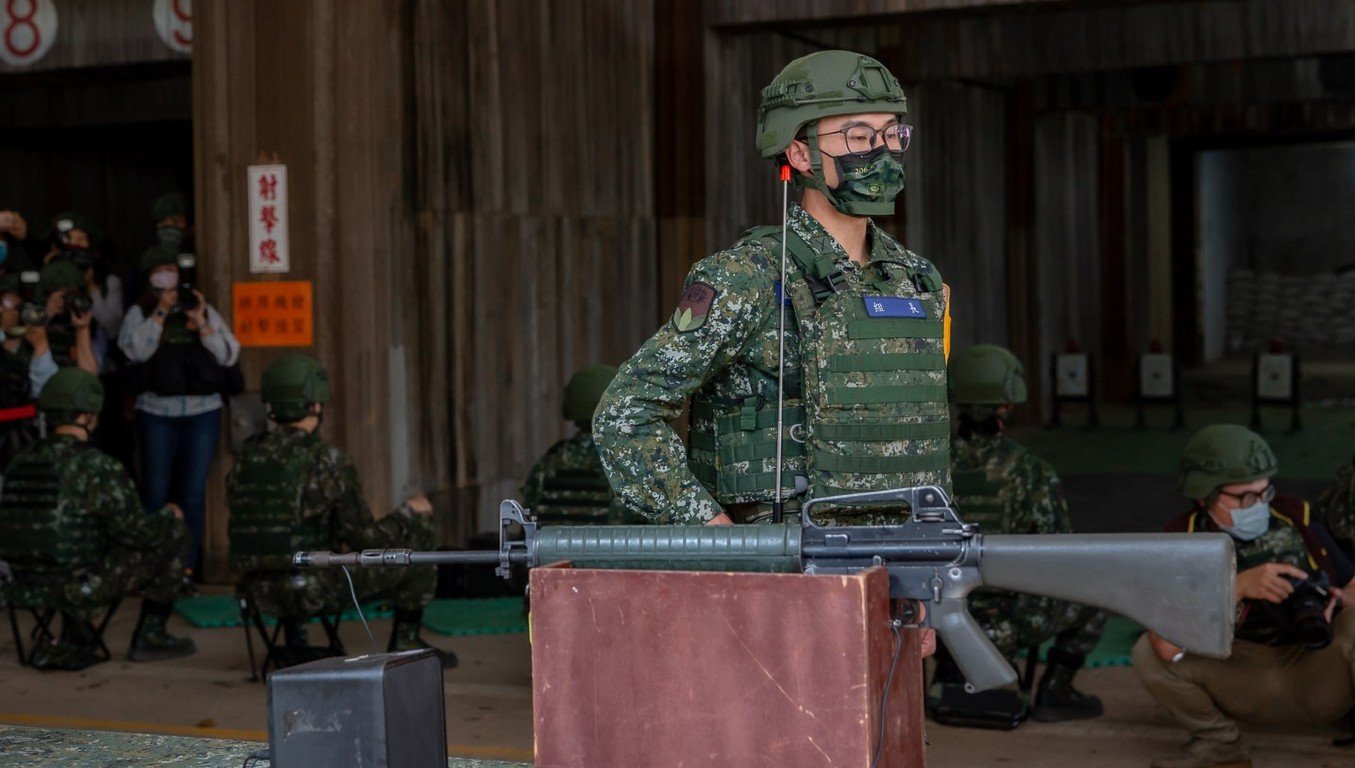
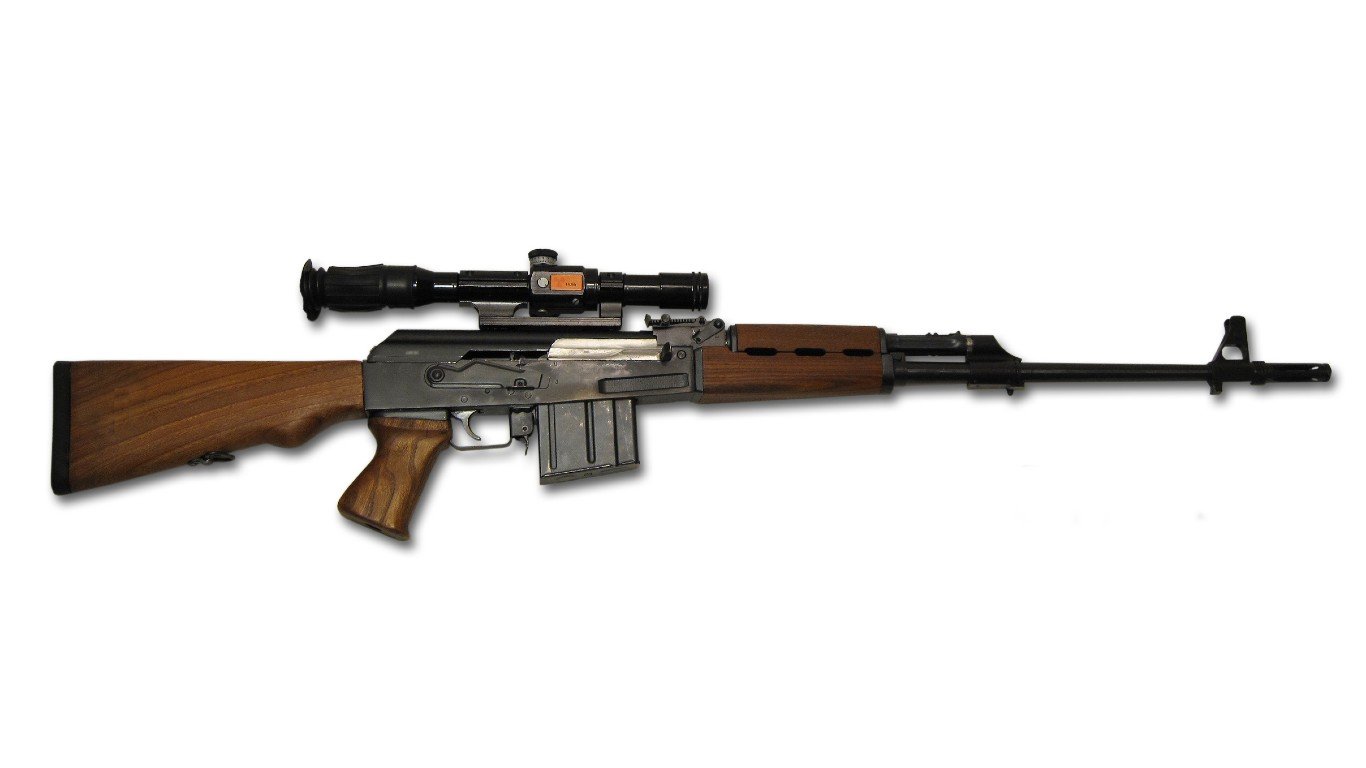
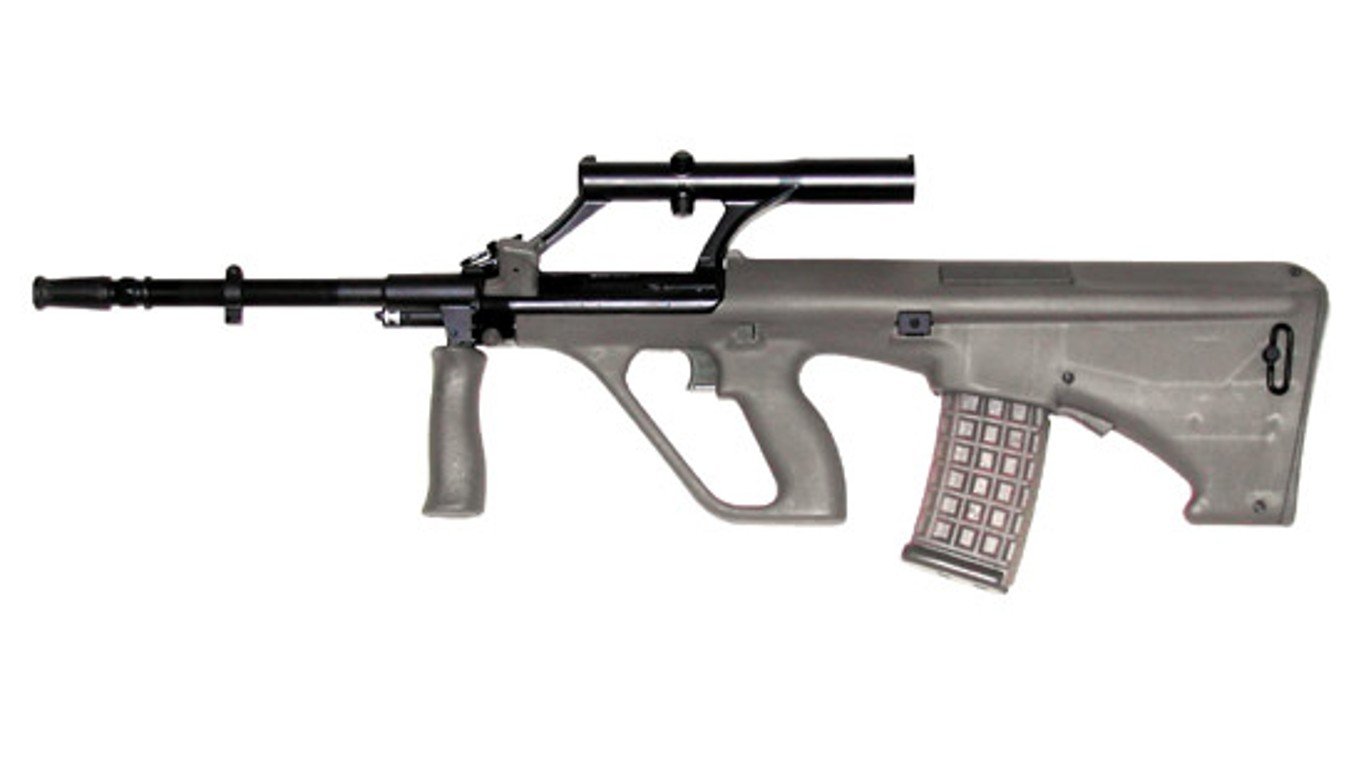
 24/7 Wall St.
24/7 Wall St.

